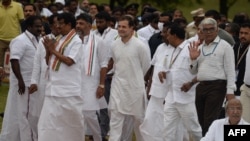India’s opposition Congress Party leader, Rahul Gandhi, has embarked on a mammoth five-month march across the country as he seeks to resurrect his party’s political fortunes before 2024 general election.
The “Grand Old Party” that dominated India’s politics for over five decades has been pushed to the margins since 2014, when the Hindu nationalist Bharatiya Janata party of Prime Minister Narendra Modi rose to power.
The 3,570-kilometer trek across 12 states that began Thursday amid the sound of drumbeats and waving of national flags, has been billed as a “Bharat Jodo Yatra” or “Unite India March.” Starting from the southern state of Kerala, it will end up in the north in Kashmir. It is taking place as opposition parties accuse the ruling BJP of polarizing the country along religious lines and weakening democratic institutions.
Praying at a memorial in the southern state of Tamil Nadu, where his father, Rajiv Gandhi, was assassinated in 1991 by a Tamil suicide bomber, Gandhi tweeted before embarking on the march, “I lost my father to the politics of hate and division. I will not lose my beloved country to it too.
The party seems to be emulating a tradition of long political marches in India. The most famous was led by independence leader Mahatma Gandhi in 1930 to resist British rule. Another political roadshow led by BJP leader Lal Krishna Advani in 1990 to campaign for building a Hindu temple at the site of a mosque catapulted the party into national prominence.
Calling the Congress Party’s march a landmark occasion, the party president, Sonia Gandhi, said, “I am confident our organization will be rejuvenated.”
After two humiliating defeats in general elections in 2014 and 2019 under Rahul Gandhi’s leadership, the party has also suffered significant losses in state elections in recent years. It is being called a dispirited party that has floundered in its bid to counter the dramatic rise of the BJP.
“It’s quite a hill they have to climb. In the last two elections, the BJP has substantially increased its vote share and it also seems to have spread to many parts of the country, east, northeast, even parts of south, where it was marginal. And the personal appeal of Mr. Modi is probably more than that of any other leader in decades,” said Mahesh Rangarajan, a professor of history at the Ashoka University.
“From the Congress party’s point of view, this outreach is a major initiative to give their party a boost and an impetus,” he said.
At the same time, analysts also question whether the long march will be enough to lift the party out of its deep political slump ahead of the 2024 election without addressing the core problems that have led to its decline.
Walking about 20 kilometers a day and spending the night in makeshift accommodations, Gandhi aims to connect with India’s people, according to senior Congress leaders, who are calling it a “mass mobilization” program.
Although he stepped down as party president in 2019, Gandhi is seen as the de facto leader in a party that has been dominated by the Nehru-Gandhi family.
However, there have been many questions raised over his leadership.
A string of senior leaders has quit the party in recent years – the most recent to leave, Ghulam Nabi Azad, called Gandhi "immature" and "childish," and accused the leadership of "foisting a nonserious individual" at the helm of the party. Little attention was given to a group of 23 leaders who last year demanded reform in a party long accused of following dynastic politics.
“The big problem leading to the Congress Party’s massive decline is that sections of party leaders are losing trust in their own leader and voters are also losing trust in the leadership of the Congress. The leader is not even seen as legitimate within his own party,” according to Sanjay Kumar at the Center for the Study of Developing Societies in New Delhi. “That is the biggest crisis facing the Congress,” he said.
Other analysts agree. They say, while the campaign marks a starting point to revive the party, it has simply not done enough in recent years to offer a credible alternative to the BJP and to Modi, whose rankings continue to stay high despite such problems as mounting unemployment and inflation.
“Rahul Gandhi simply has not clicked with the people of India. And the Congress Party is showing little signs of reviving. It has been accused of becoming a party that is flabby, stagnant, a party of the drawing room, used to being in power while the leadership is accused of entitlement in a young, aspirational India,” said independent political analyst Neerja Chowdhury. “To hit the road again and go back to the people is a good idea but it is uncertain whether it will work,” she said.
The jury is out on whether the march can help the Congress Party’s revival.
“Can this stand-alone event do it? There is a big question mark on it,” Kumar said, although, according to him, it could “trigger a momentum in favor of the party and have some positive impact on its image if not its electoral prospects.”




